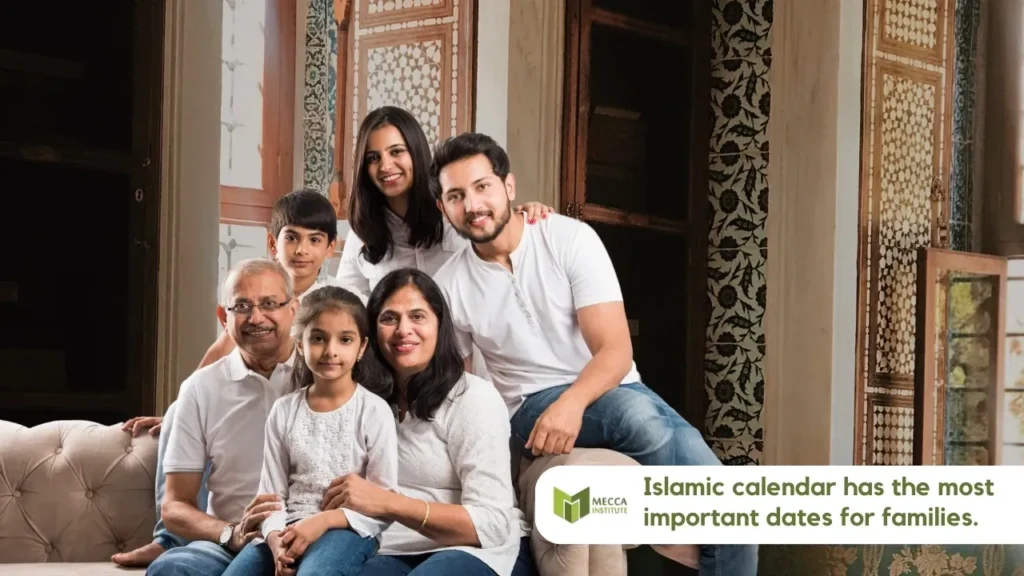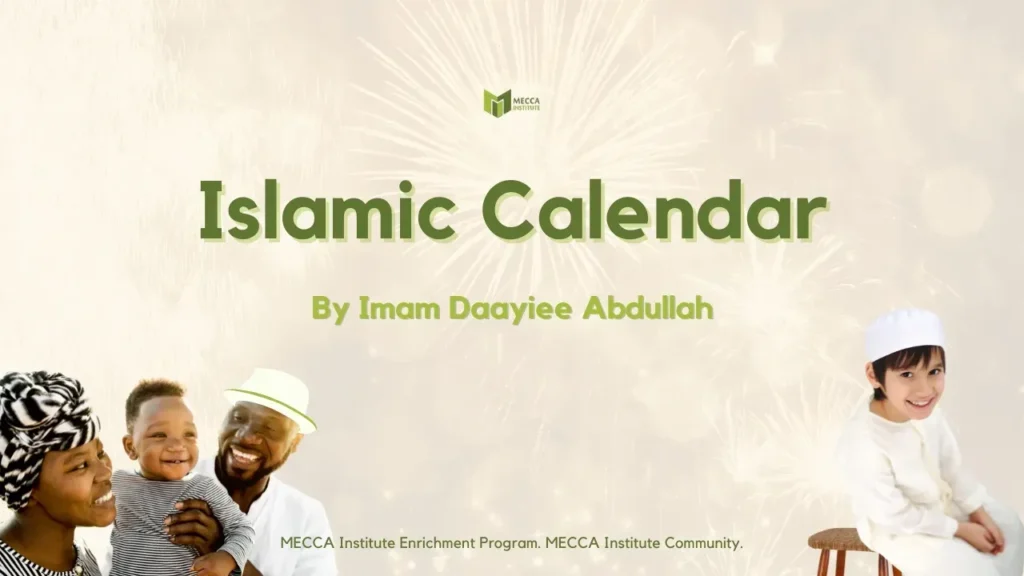The Islamic calendar is an important part of the Muslim faith, says Imam Daayiee Abdullah, noting that it guides the holy events throughout the year.
Important Muslim rituals like fasting, pilgrimage, and almsgiving all rely on the Islamic calendar. This lunar-based calendar has been in operation since the 7th Century CE.
Popular Muslim holidays like the Muslim New Year, Eid, and Mawlid all require the Islamic calendar to plan.
Although most Muslim cultures rely on the Gregorian calendar for their civil activities, the Islamic calendar remains spiritually important to us.
Islamic Calendar
All the calendars in the world came from specific people in a particular place, and they tend to have meaning for them only. For example, when I first traveled to China, I learned they have their own calendar, which, unlike the one I knew (Gregorian), is based on both solar and lunar.
Calendars are important to humans for many reasons, from basic needs like agricultural activities to more nuanced cultural requirements like ritual dates.
Muslims are not any different, and we have our own Islamic calendar.
The Islamic calendar began in the early days of Islam in Medina (in today’s Saudi Arabia) in 622 CE in the Gregorian calendar. Muslims call the Islamic calendar “Hijri” (“تقويم هجري” or “Taqwīm Hijrī”) because it marks Prophet Muhammad’s migration from Mecca to Medina. In Arabic, a migration is “hijra.”
The Hijri calendar follows a lunar cycle of 12 months. Months have either 29 or 30 days, and together, they total 354 or 355 days in a year.
Muslims use this calendar to determine Islamic rituals like the Hajj pilgrimage, holidays like Eid, and annual events like fasting in Ramadan. As a result, with the exception of a few like Saudi Arabia, most Muslim cultures use this calendar for religious purposes only.
Islamic Calendar Months

The Islamic calendar has unique names for the months. The months are Muharram, Safar, Rabi’ al-Awwal, Rabi’ al-Thani, Jumada al-Awwal, Jumada al-Thani, Rajab, Sha’ban, Ramadan, Shawwal, Dhu al-Qi’dah, and Dhu al-Hijjah.
These months follow the lunar cycle, with each month starting with the sighting of the new moon. A new moon is called “Hilal” (الهلال).
The length of each month alternates between 29 and 30 days, leading to a total of either 354 or 355 days in a Hijri year.
Serving more than a quarter of the human population, the months in the Islamic calendar see plenty of activities, starting with the New Year on Muharram 1st.
As the year drags on, other important dates show up, including Mawlid on the 12th day of Rabi’ al-Awwal, Ramadan in the entire ninth month, Eid al-Fitr on the first day of Shawwal, and Hajj and Eid al-Adha in the first half of Dhu al-Hijjah.
Depending on specific cultures, there are also plenty of other holidays scattered throughout the year, including Sufi dates like Rumi’s Urs, Ashura for Shias, and so much more.
Muslim New Year
The Muslim New Year marks the beginning of the Islamic calendar year and its observation is on the first day of Muharram, the first month of the Islamic calendar.
In diverse cultures, it has different names, including “Islamic New Year” and “Hijri New Year.”
The Muslim New Year is a time for reflection, prayer, and seeking blessings for the year ahead. Unlike the mainstream or Gregorian New Year, this is a somber celebration in most Muslim cultures.
People will go to the local mosque, spend time with spiritual thoughts, and are otherwise occupied with thoughts about their mortality and the growing number of years.
Therefore, the Muslim New Year is not celebrated with as much festivity as Eid al-Fitr or Eid al-Adha.
Ramadan Dates
Ramadan (رمضان) dates are easy to identify because it is in the entire ninth month of the Islamic calendar. This is considered the holiest month for Muslims. Its holy nature comes from the fact that it is the month in which the Quran was first revealed to Prophet Muhammad.
Quranic verses mandate that Muslims fast in this month. As a result, Ramadan is a time of spiritual reflection, self-discipline, increased prayer, and acts of charity. People are very intentional this month because of its potential for immense rewards and forgiveness from God.
Even though fasting is challenging on the body as it requires abstaining from food, drink, smoking, and other physical needs, Muslims are in a joyful mood, much like the Christmas Season for Christians. You will see people greeting one another with “Ramadan Mubarak!” (Blessed Ramadan!).
As with any Islamic date, its exact dates vary each year in conjunction with solar calendars, including the Gregorian, which is a civil calendar in most Muslim countries.
Likewise, because Ramadan begins with the sighting of the new moon, Muslims in different areas of the world traditionally started their fasting on different dates. As technology got better, however, it cut down the discrepancies, and most Muslims now tend to agree on the dates.
Similarly, because Muslims fast from dawn until sunset, Muslims in different areas of the world break their fast at different lengths. In 2023, for example, Muslims in Greenland had to fast for 18 hours, while those in New Zealand only had to fast for about 12 hours per day.
Eid Dates

Eid, which means “festival” in Arabic, is the most popular holiday in Muslim communities around the world. There are two Eids, and they are about three months apart.
The first Eid is Eid al-Fitr (الفطر), the Festival of Breaking the Fast that marks the end of the fasting month of Ramadan. As a result, this Eid falls on the first day of Shawwal, the tenth month of the Islamic calendar. Eid al-Fitr is a big celebration where Muslims celebrate with communal prayers, feasting on sweets, giving of gifts, and acts of charity.
The second Eid is Eid al-Adha (الأضحى), the Festival of Sacrifice that commemorates Prophet Abraham’s willingness to sacrifice his son as an act of obedience to God. As a result, Muslims worldwide celebrate by performing the symbolic ritual of animal sacrifice and sharing the meat with family, friends, and those in need.
Both Eids are a great time for children, who receive eidi (“عيدية” or Eidiyah), money or gifts as a token of blessings from elders in the family. It has different names in diverse Muslim cultures, but the practice is the same. For example, in Saudi Arabia, it’s commonly called “haq ul ‘Eid” (حق العيد) or “Eid rights.”
Likewise, people, especially children, buy new clothes for Eid, families decorate their houses with colorful lights, and there is a cheery atmosphere everywhere.
The two Eids are much bigger than the New Year in Muslim communities.
Mawlid Dates
Mawlid al-Nabi (المولد), widely shortened as “Mawlid,” is a major Muslim festival that celebrates the birth of the Prophet Muhammad. It falls on the 12th day of Rabi’ al-Awwal, the third month of the Islamic calendar.
Muslims around the world commemorate with recitations of poetry, lectures on the Prophet’s life, and communal gatherings. Wherever you go, you will feel a focus on love, peace, and unity.
In many cultures, Muslims mark the occasion by donning new attire and sharing gifts. Streets are adorned with lights, often green-colored ones, while food and sweets are generously shared among the community.
In some cultures, there is an emphasis on avoiding the holiday. For example, Wahabbis are against celebrating the Prophet’s birthday. As a result, this is not a major festival in countries like Saudi Arabia, where it is not an official holiday.
Hajj Dates
Hajj (حَجّ) is an annual Islamic pilgrimage to Mecca. It is a fundamental aspect of Islam, taking place on the 12th month of the Islamic calendar, Dhu al-Hijjah. Hajj dates are typically from the 8th and can last until the 13th day.
Muslims perform rituals, such as circling the Kaaba to symbolize unity, walking back and forth seven times between the hills of Safa and Marwa to commemorate Hagar’s search for water for her son Ishmael, throwing pebbles at three pillars (Jamrat) in Mina to reject the Devil’s temptation, and so on.
As an important pillar of Islam, Muslims are required to perform Hajj at least once in their lifetime, provided they can afford to do so. Therefore, millions of visitors head to Saudi Arabia, where the sites of the Hajj are, to partake in the pilgrimage.
Hajj is a big business for Saudi Arabia, which benefits from tourism. In 2019, about 2.5 million Muslims made their way to the country. The country makes about $20 billion each year from Hajj and its lesser pilgrimage of Umrah.
Conclusion
As previously noted, the Islamic calendar is lunar-based and consists of 12 months following the phases of the moon. This makes it shorter than the Gregorian calendar, typically 11 days shorter.
Meanwhile, the most important dates on the Islamic calendar include Eid al-Fitr and Eid al-Adha, Ramadan, Hajj, and the Muslim New Year.
Not only that, because it rotates, it changes its alignment. A typical Gregorian year will generally straddle two Islamic years. For example, 2024 sees both 1445 and 1446 Hijri years.
The Islamic calendar is used officially in some predominantly Muslim countries for religious and administrative purposes, including Saudi Arabia, Iran, Afghanistan, and others.
May Allah continue to guide us all.
Imam Daayiee Abdullah is the Executive Director of MECCA Institute and the author of “Progressive Islam,” a historic book that defines Progressive Islam.


Pingback: Eid al-Fitr Guide to Celebrate the End of Ramadan with Traditions
Pingback: Eid Foods Guide to Help You Plan the Best Festival Treats
Pingback: Islamic New Year Guide to Celebrate This Muslim Holiday - MECCA Institute
Pingback: Mawlid Guide for the Beautiful Celebration of Prophet Muhammad - MECCA Institute
Pingback: Islamic Calendar -
Pingback: Being Gay and Muslim - Navigating Identity and Faith in Islam
Pingback: Muslim Wedding Guide to Traditions, Service, Dress, and More - MECCA Institute
Pingback: Ramadan Guide for Preparations, Fasting, Traditions, and More - MECCA Institute
Pingback: Muslim Prayer Guide for the Most Amazing Spiritual Experience - MECCA Institute
Pingback: Sharia Law Countries Guide to Use for Proactive Safety - MECCA Institute